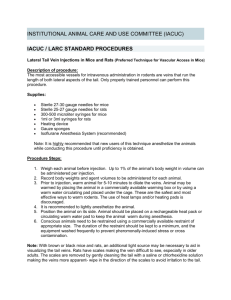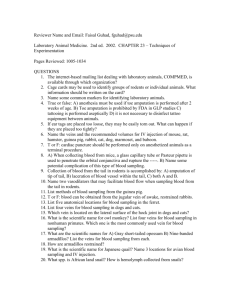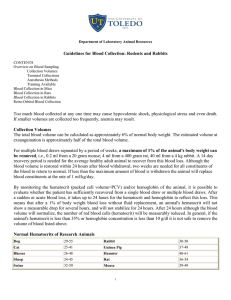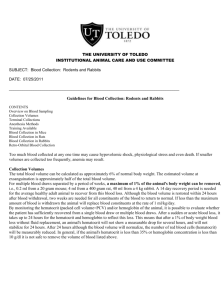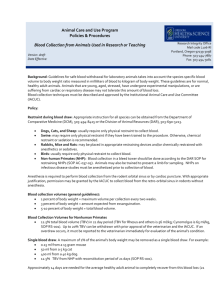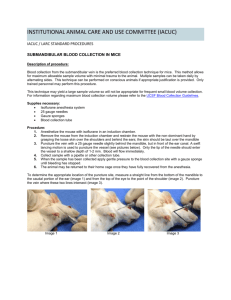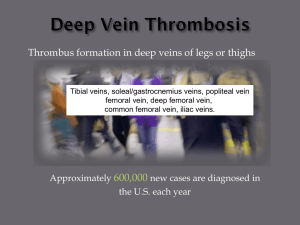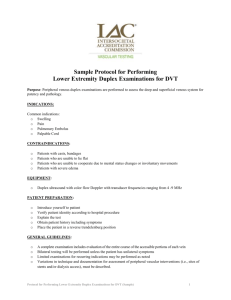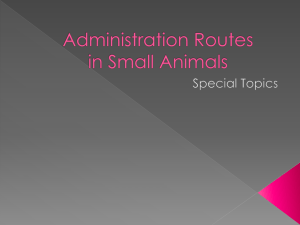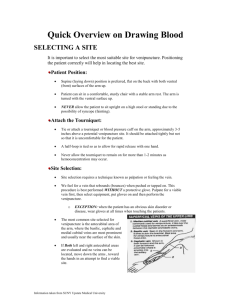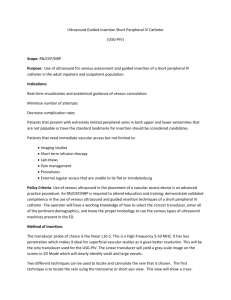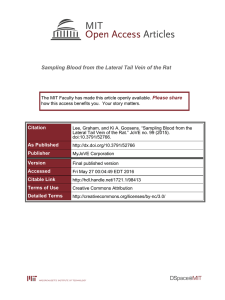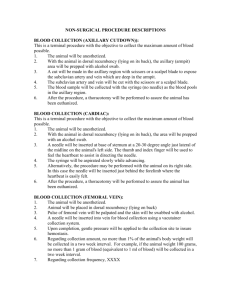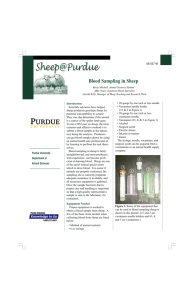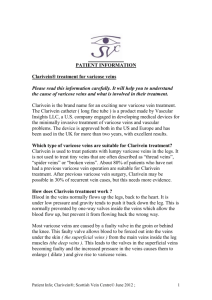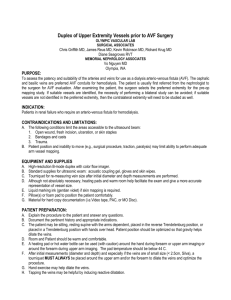Blood Collection
advertisement
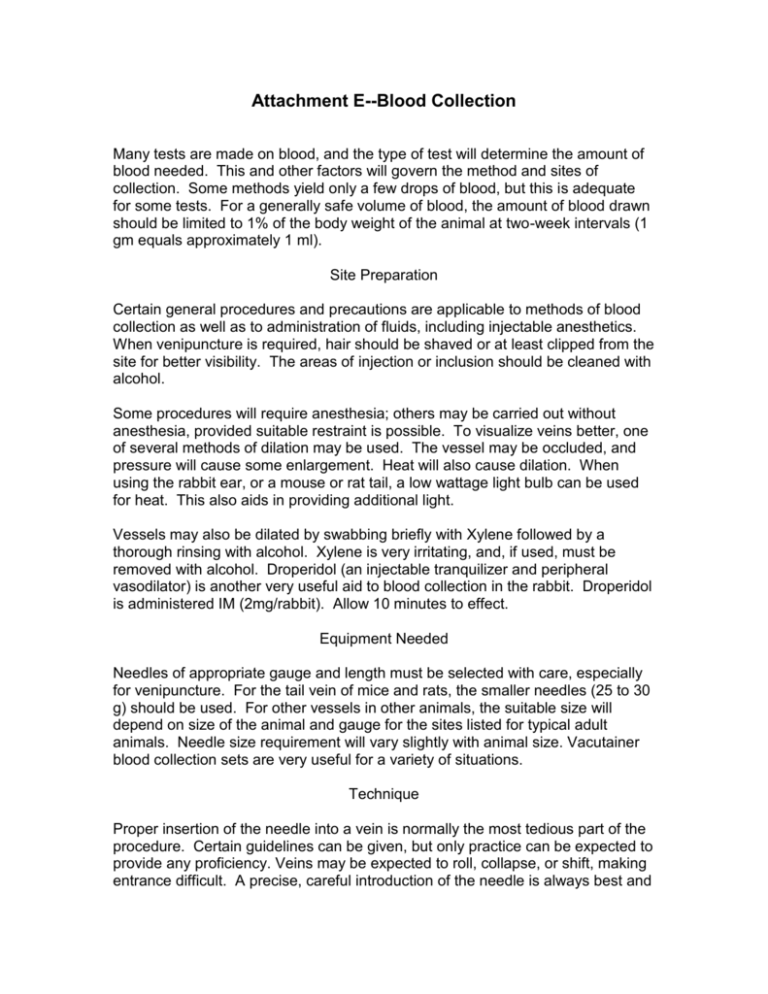
Attachment E--Blood Collection Many tests are made on blood, and the type of test will determine the amount of blood needed. This and other factors will govern the method and sites of collection. Some methods yield only a few drops of blood, but this is adequate for some tests. For a generally safe volume of blood, the amount of blood drawn should be limited to 1% of the body weight of the animal at two-week intervals (1 gm equals approximately 1 ml). Site Preparation Certain general procedures and precautions are applicable to methods of blood collection as well as to administration of fluids, including injectable anesthetics. When venipuncture is required, hair should be shaved or at least clipped from the site for better visibility. The areas of injection or inclusion should be cleaned with alcohol. Some procedures will require anesthesia; others may be carried out without anesthesia, provided suitable restraint is possible. To visualize veins better, one of several methods of dilation may be used. The vessel may be occluded, and pressure will cause some enlargement. Heat will also cause dilation. When using the rabbit ear, or a mouse or rat tail, a low wattage light bulb can be used for heat. This also aids in providing additional light. Vessels may also be dilated by swabbing briefly with Xylene followed by a thorough rinsing with alcohol. Xylene is very irritating, and, if used, must be removed with alcohol. Droperidol (an injectable tranquilizer and peripheral vasodilator) is another very useful aid to blood collection in the rabbit. Droperidol is administered IM (2mg/rabbit). Allow 10 minutes to effect. Equipment Needed Needles of appropriate gauge and length must be selected with care, especially for venipuncture. For the tail vein of mice and rats, the smaller needles (25 to 30 g) should be used. For other vessels in other animals, the suitable size will depend on size of the animal and gauge for the sites listed for typical adult animals. Needle size requirement will vary slightly with animal size. Vacutainer blood collection sets are very useful for a variety of situations. Technique Proper insertion of the needle into a vein is normally the most tedious part of the procedure. Certain guidelines can be given, but only practice can be expected to provide any proficiency. Veins may be expected to roll, collapse, or shift, making entrance difficult. A precise, careful introduction of the needle is always best and several attempts may be required. The needle is inserted parallel to the vein and the tip directed into the lumen along the longitudinal axis. When withdrawing blood from a vein, aspiration should be slow so the vessel does not collapse. The heart puncture is generally the most practical method of blood collection from small rodents when more than a few drops are required. It also has some use for the larger laboratory species. This should only be done as a terminal procedure. The animal should be euthanized while under anesthesia. Animals must be completely anesthetized and restrained in dorsal recumbency. The point of strongest heartbeat is determined with the forefinger and with the needle inserted directly into the heart. Blood should be withdrawn slowly so as not to collapse the heart (Vacutainer sets are useful here). The marginal veins or central artery of the rabbit ear is useful for collection of blood in this species. The area is shaved and cleaned with soap and water then alcohol. The vein is occluded, and the needle is carefully inserted and the blood slowly withdrawn. Gauze held in place for a few minutes will prevent hematomas from forming. The best method to collect large volumes of blood from the rabbit employs the central ear artery using a vacutainer blood collection set, or a plain needle attached to a silicon coated tube. 30-40 cc of blood can be collected in this manner but the rabbit must be carefully restrained, and hematomas must be prevented. Small amounts of blood that may be obtained by cutting the toenails of guinea pigs or rabbits or the tips of tails of mice and rats normally yielding a few drops. Collect in a heparinized glass capillary tube. The amount from these cuts is adequate for hemoglobin, microhematocrit and cell counts. Bleeding from the tail may be increased by warming it in water at 40 to 50 degrees Celsius. Animals should be restrained in a suitable restraining device or wrapped in a towel. After cleaning, 1 to 2 millimeters of the tip of the tail is cut off and blood collected at this point. When blood does not readily appear, there is often the temptation to "milk" the tail to induce blood flow. This must be avoided because it expresses other body fluids and gives an incorrect sample. The blood collected should be free flowing. Clipping is the least preferable method of blood collection. Withdrawal of blood and intravenous injection by way of the tail vein in mice and rats is possible. The veins may be seen laterally near the base of the tail, but good illumination and dilation will normally be required. Bleeding from the jugular vein, common in large animals, is difficult in laboratory animals, except for dogs and cats. In the smaller species, exposure of the vein under the skin by surgical cut-down is usually required if this vein is to be used. Bleeding from the orbital venous plexus of rats, and orbital sinus of mice and hamsters is frequently used. One-quarter ml can be collected from mice at weekly intervals using this technique. When bleeding the mouse, hamster and rat by the peri-orbital technique, the capillary tube is directed into the orbital sinus, which fills the orbit and surrounds the globe. When hamsters are being bled, the capillary tube is directed caudally to the caudal venous sinus. Bleeding of the rat in the peri-orbital region is facilitated when the capillary tube is directed from above the globe, and then caudally toward the major venous anastomosis between the deep and superficial veins of the orbit . Knowledge of the location of the venous structures of the orbit of the mouse, hamster and rat aids in establishing a successful peri-orbital bleeding technique. Light anesthesia is required for all peri-orbital bleeding procedures. The veterinarians and veterinary technicians of Veterinary Resources are available for guidance in these and other techniques. Instructional videos are also available. Commonly Used Sites for Blood Withdrawal from Laboratory Animals Species Heart1 Rat 1” 22 ga ¾” 25 ga ¾” 25 ga 1½” 16 ga 1½” 22 ga Mouse Hamster Rabbit Guinea Pig Cephalic Vein Saphenous Vein Femoral Artery Jugular Vein ¾” 25 ga2 X2 X2 X2 X2 Ear Artery X2 ½” 27 ga ¾” 27 ga X2 X2 X2 X2 Tail Artery Orbital Sinus1,4 ½” 25 ga3 ½” 27 ga2 X Tail or Toe Clipping5 X X X X X 1” 23 ga Notes: 1 2 3 4 5 Acceptable only if the animal is under anesthesia Usually requires a skin incision. Subject must be anesthetized. Needle size may vary from ½” 25ga to 1” 22ga Difficult to master Microhematocrit tubes (heparinized): drawn Pastuer pipette Method is not preferred because sample contains tissue fluid and may require anesthesia and/or post procedure care X

